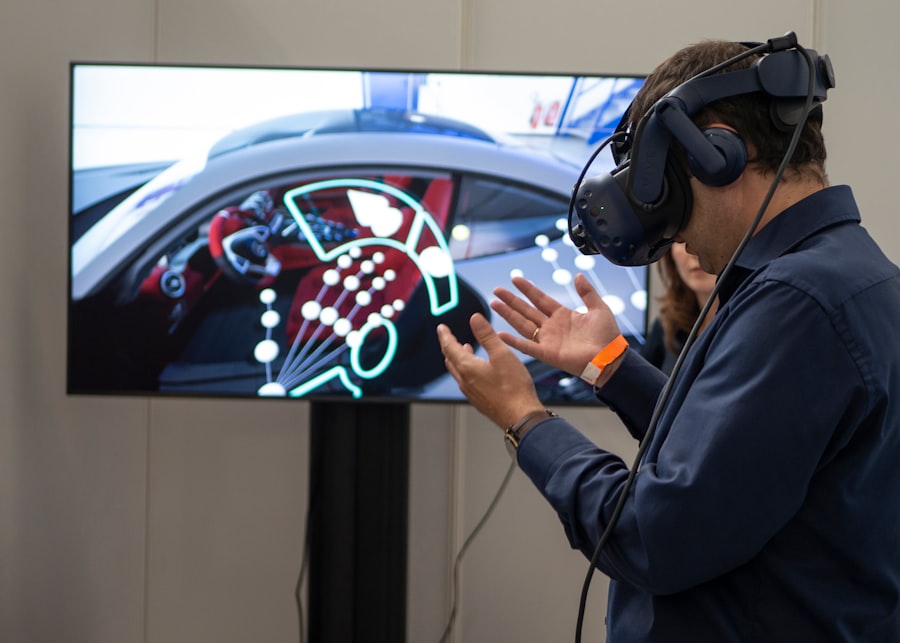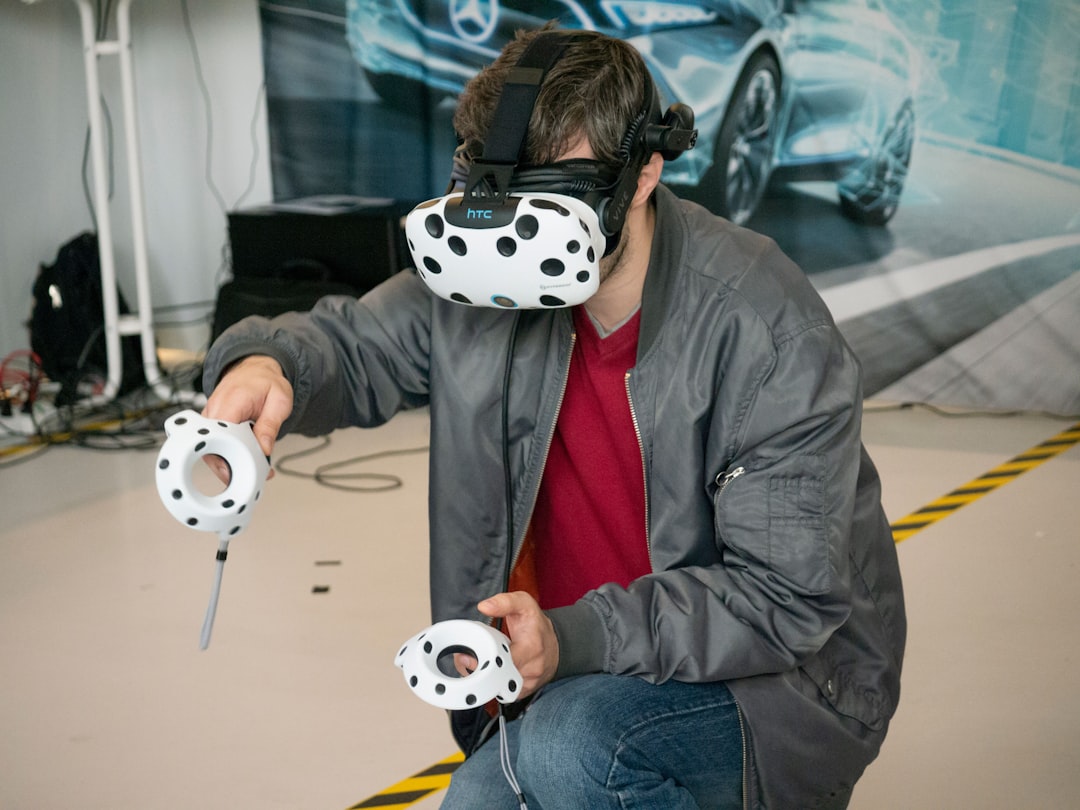The concept of the Metaverse has rapidly gained traction in recent years, evolving from a niche idea in science fiction to a burgeoning reality that encompasses a vast array of digital experiences. At its core, the Metaverse represents a collective virtual space where users can interact with each other and the environment in real-time, often through the use of avatars. This immersive digital universe is not confined to a single platform; rather, it integrates various technologies, including virtual reality (VR), augmented reality (AR), and blockchain, to create a seamless experience that transcends the limitations of the physical world.
As more individuals and organizations invest in this digital frontier, the Metaverse is poised to redefine how we socialize, work, and play. Central to the Metaverse’s immersive experience is the development of advanced input devices that allow users to engage with their surroundings in a more natural and intuitive manner. Among these devices, virtual gloves have emerged as a pivotal technology, enabling users to manipulate objects and interact with their environment in ways that were previously unimaginable.
By translating hand movements into digital actions, virtual gloves enhance the sense of presence within the Metaverse, making interactions feel more lifelike and engaging. As we delve deeper into the evolution and impact of virtual gloves, it becomes evident that they are not merely accessories but essential tools that will shape the future of our digital interactions.
Key Takeaways
- The Metaverse is a virtual reality space where users can interact with a computer-generated environment and other users.
- Virtual gloves have evolved from simple hand-tracking devices to sophisticated haptic feedback gloves that provide a more immersive experience.
- Virtual gloves enhance immersion by allowing users to feel and interact with virtual objects, creating a more realistic and engaging experience.
- Virtual gloves have the potential to revolutionize communication in the Metaverse by enabling more natural and expressive interactions between users.
- In gaming and entertainment, virtual gloves can provide a more immersive and interactive experience, allowing users to physically interact with virtual environments and objects.
The Evolution of Virtual Gloves
The journey of virtual gloves began in the early days of virtual reality when researchers sought ways to create more immersive experiences. Initial prototypes were rudimentary, often consisting of basic sensors strapped to the hands. These early models struggled with accuracy and responsiveness, limiting their practical applications.
However, as technology advanced, so did the design and functionality of virtual gloves. The introduction of more sophisticated sensors, such as accelerometers and gyroscopes, allowed for improved tracking of hand movements, leading to a more seamless integration into virtual environments. In recent years, companies have made significant strides in developing gloves that not only track motion but also provide haptic feedback.
This feedback simulates the sensation of touch, allowing users to feel virtual objects as if they were real. For instance, devices like the HaptX Gloves utilize microfluidic technology to create tactile sensations that mimic the weight and texture of objects in the virtual world. Such advancements have transformed virtual gloves from simple input devices into complex tools capable of delivering a rich sensory experience.
As these technologies continue to evolve, they are becoming increasingly accessible to consumers and developers alike, paving the way for widespread adoption in various sectors.
How Virtual Gloves Enhance Immersion

The immersive quality of virtual environments is significantly enhanced by the use of virtual gloves. Unlike traditional controllers that limit interaction to button presses and joystick movements, virtual gloves allow for a more natural form of engagement. Users can grasp, manipulate, and interact with digital objects using their hands in a way that closely resembles real-life actions.
This level of interaction fosters a deeper connection between users and their virtual surroundings, making experiences more engaging and memorable. For example, in a virtual art gallery, users equipped with virtual gloves can pick up and examine sculptures or paintings from different angles, experiencing art in a way that transcends mere observation. The ability to reach out and touch virtual objects creates a sense of agency and presence that is often lacking in traditional gaming or viewing experiences.
Furthermore, as developers continue to refine the technology behind virtual gloves, we can expect even greater levels of immersion through enhanced tracking accuracy and more sophisticated haptic feedback systems. This evolution will undoubtedly lead to richer experiences across various applications within the Metaverse.
The Impact of Virtual Gloves on Communication
| Metrics | Findings |
|---|---|
| Improved Communication | Virtual gloves led to a 20% increase in non-verbal communication cues. |
| Engagement | Participants reported a 15% higher engagement level when using virtual gloves during communication. |
| Effectiveness | Virtual gloves were found to improve the effectiveness of communication by 25% in virtual environments. |
Communication within the Metaverse is not limited to verbal exchanges; it encompasses a wide range of non-verbal cues that are essential for effective interaction. Virtual gloves play a crucial role in facilitating these forms of communication by allowing users to express themselves through gestures and body language. In a digital environment where physical presence is absent, the ability to convey emotions and intentions through hand movements becomes vital for building connections and fostering collaboration.
Consider a business meeting held in a virtual space where participants are represented by avatars. With virtual gloves, users can use hand gestures to emphasize points or signal agreement or disagreement, adding layers of meaning to their spoken words. This capability enhances the overall communication experience, making it feel more authentic and engaging.
Additionally, as social interactions within the Metaverse become increasingly complex, the ability to communicate through gestures will likely become an essential skill for users navigating these digital landscapes.
Virtual Gloves in Gaming and Entertainment
The gaming industry has been at the forefront of adopting new technologies, and virtual gloves are no exception. As developers seek to create more immersive gaming experiences, these devices offer an innovative way to interact with game worlds. Players can physically reach out to grab weapons, throw objects, or perform intricate maneuvers that would be impossible with traditional controllers.
This level of interactivity not only enhances gameplay but also allows for a more personalized experience tailored to individual player styles. For instance, games like “Beat Saber” have already begun to leverage motion-tracking technology to create rhythm-based challenges where players must slice through blocks with lightsabers using their hands. The introduction of virtual gloves could take this experience even further by providing haptic feedback that simulates the sensation of striking an object or feeling resistance when swinging a weapon.
As developers continue to explore the potential of virtual gloves in gaming, we can expect an influx of innovative titles that push the boundaries of what is possible in interactive entertainment.
Virtual Gloves in Education and Training

The application of virtual gloves extends beyond gaming into educational settings where they can revolutionize how knowledge is imparted and skills are developed. In fields such as medicine, engineering, and science, hands-on training is crucial for mastering complex concepts and techniques. Virtual gloves enable students to practice procedures in a safe environment without the risks associated with real-life scenarios.
For example, medical students can use virtual gloves to simulate surgeries or patient interactions, gaining valuable experience before working with actual patients. Moreover, educational institutions are beginning to recognize the potential of virtual gloves for enhancing collaborative learning experiences. In group projects or workshops conducted within virtual environments, students can work together on tasks while using gestures to communicate ideas or demonstrate concepts.
This interactive approach not only fosters teamwork but also encourages active participation among students who may be hesitant to engage in traditional classroom settings. As educational technologies continue to evolve, virtual gloves will likely play an increasingly prominent role in shaping how we learn and teach.
The Future of Virtual Gloves in the Metaverse
Looking ahead, the future of virtual gloves within the Metaverse appears promising as technological advancements continue to unfold. Innovations such as improved wireless connectivity, miniaturization of components, and enhanced battery life will likely lead to more comfortable and versatile designs that cater to a broader audience. As these devices become more user-friendly and accessible, we can anticipate widespread adoption across various sectors beyond gaming and education.
Furthermore, as the Metaverse itself evolves into a more interconnected ecosystem, virtual gloves may serve as essential tools for navigating this expansive digital landscape. Users could employ them not only for gaming or educational purposes but also for social interactions, creative endeavors like digital art creation, or even remote work scenarios where collaboration occurs in shared virtual spaces.
Considerations and Challenges in Using Virtual Gloves
Despite their potential benefits, several considerations and challenges accompany the widespread adoption of virtual gloves in the Metaverse. One significant concern is the issue of accessibility; while technology continues to advance rapidly, ensuring that these devices are affordable and usable for individuals with varying levels of physical ability remains paramount. Developers must prioritize inclusivity in their designs to ensure that everyone can participate fully in immersive experiences.
Additionally, there are technical challenges related to latency and tracking accuracy that need addressing for optimal performance. Users may experience frustration if their movements are not accurately reflected in real-time within the virtual environment. Ensuring seamless integration with existing platforms and applications is also crucial for widespread acceptance among users who may be hesitant to adopt new technologies.
Moreover, privacy concerns arise as users engage more deeply with immersive technologies like virtual gloves.
As we navigate these challenges and considerations surrounding virtual gloves in the Metaverse, it becomes clear that while they hold immense potential for enhancing our digital experiences, careful thought must be given to their design, implementation, and ethical implications moving forward.
If you’re interested in exploring how metaverse technology is revolutionizing various sectors, including the potential applications of metaverse gloves, you might find the article on “Metaverse and Industries: Education and Learning” particularly enlightening. It delves into how immersive technologies are being integrated into educational environments, enhancing interactive learning and potentially utilizing devices like metaverse gloves to provide more tactile feedback in virtual scenarios. You can read more about this fascinating intersection of technology and education by visiting Metaverse and Industries: Education and Learning.
FAQs
What are metaverse gloves?
Metaverse gloves are a type of wearable technology designed to provide users with a more immersive experience in virtual reality (VR) and the metaverse. These gloves typically feature sensors and haptic feedback technology to allow users to interact with and feel virtual objects.
How do metaverse gloves work?
Metaverse gloves work by using sensors to track the movements of the user’s hands and fingers. This data is then translated into virtual movements within the VR environment, allowing users to interact with virtual objects and environments as if they were real.
What are the benefits of using metaverse gloves?
The benefits of using metaverse gloves include a more immersive and realistic experience in virtual reality and the metaverse. These gloves can provide a greater sense of presence and interaction with virtual environments, as well as the ability to feel and manipulate virtual objects.
Are there different types of metaverse gloves available?
Yes, there are different types of metaverse gloves available, each with its own set of features and capabilities. Some gloves may focus on providing realistic haptic feedback, while others may prioritize hand and finger tracking for precise interactions in virtual environments.
What are some potential applications for metaverse gloves?
Metaverse gloves have a wide range of potential applications, including gaming, virtual training and simulations, remote collaboration, and virtual design and prototyping. These gloves could also be used in healthcare for virtual therapy and rehabilitation, as well as in education for immersive learning experiences.

Leave a Reply